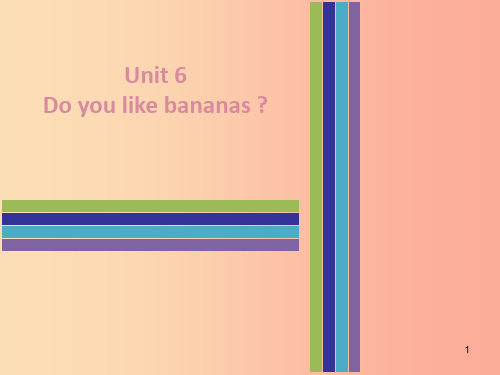2019年秋七年级英语上册 Unit 6 Do you like bananas(第2课时)分层训练
- 格式:ppt
- 大小:1.15 MB
- 文档页数:29


Teaching PlanTeacher:于文Topic: Section A, U6,(Do you like bananas?), BIA(Go For It)Time: Oct 27th, 2010Teaching Aims: Vocabulary about food; Talk about likes and dislikes. Teaching methods: Task-based Language Teaching ApproachTeaching aids: Food (fruit, vegetables); CAITeaching Procedures:Step 1 Lead-in1.Teacher and students talk about the title.2.Students pick out the things they have already known.Step 2 Presentation1.New words.(hamburger, tomato, orange, salad, strawberry, pear, broccoli, ice cream, French fries)2. More words:Step 3 1aMatch the words with the food in the picture.Step 4 Listening practice1. 1b. Listen and number the conversations1-3.2. 2a. Listen and circle the food students hear.3. 2b. Listen again and fill in the blanks.Step 5 Pairwork & Groupwork1. Pairwork.2.Groupwork. Four students a group.A: Do you like hamburgers?B: Yes, I do. I like hamburgers.(No, I don’t. I don’t like hamburgers.)C: Does he/she like hamburgers?D: Yes, he/she does. He/She likes hamburgers.(No, he/she doesn’t. He/She doesn’t like hamburgers.)…Step 6 More PracticeStep 7 SummaryKey words, Key sentences & Grammar.Step 8 Homework1. Look up more words about food.What kinds of food do you think are healthy or unhealthy? Discuss in pairs or small groups about a healthy lunch.2. What do your parents like to eat? Make a survey.Blackboard Design:Unit 6 Do you like bananas?hamburger(s) I/They like bananas.tomato(es) Do you/they like bananas?orange(s) Yes, I do./ No, I don’t.salad She/He likes bananas.strawberry(berries) D oes she/he like bananas?pear(s) Yes, she/he does./ No, she/he doesn’t.Students’ PaperI. Fill in the blanks.( The more, the better.)II. Give out pl. forms. (eg. egg eggs )Fruit(s):apple ______ pear ______ mango ______ strawberry ______ orange ______ blueberry ______Vegetables:carrot ______ potato ______ broccoli ______Other food:sandwich ______ rice ______ egg ______ ice cream ______ hamburger ______ hot dog ______ juice ______ milk ______ chicken ______ salad ______III. like/ likes; do/ does?1.I ______ eggplants. Do you ______ eggplants?2.--- Do they ______ broccoli?--- Yes, they ______.3.--- Does she ______ bananas?--- Yes, she ______. She ______ bananas very much.4.--- ______ you ______ vegetables?--- No, I don’t.Homework1. Look up more words about food.。

Unit 6 Do you like bananasSection A (1a-2d)总分:60分时间:30分钟Ⅰ.用括号内所给单词的适当形式填空(本题包括4小题,每题2.5分,共10分)1.There are some (strawberry) on the plate.2.I have some(salad) for dinner.3.Do you like (tomato)?4.I like (pear),but I don’t like oranges.Ⅱ.单项选择(本题包括5小题,每题2分,共10分)1.— you pears?—No,I don’t.I like apples.A.Do;likeB.Does;likeC.Do;likesD.Does;likes2.She eggs.A.doesn’t likeB.don’t likeC.doesn’t likesD.don’t likes3.—Do you like fruit?—.A.Yes,I amB.No,I am notC.Yes,I don’tD.No,I do n’t4.Bob ice-cream,but Bill it.A.like;don’t likeB.like;doesn’t likees;don’t like5. Jim and Jack strawberries?A.Do;likesB.Do;likeC.Does;likeD.Does;likesⅢ.根据图片, 完成对话(本题包括10小题,每题2分,共20分)A:Excuse me.Who’s that 1. in the picture?B:Oh, that’s 2. sister.A:Does your sister 3. rice?B:Yes, she likes 4. very much.A:Does she like 5.?B:6., she likes them.A:Does she like 7.?B:8., she 9. 10. like it.Ⅳ.完成句子(本题包括2小题,每题5分,共10分)1.——你喜欢牛奶吗?——是的,我喜欢。



人教版七年级上册英语Unit6 Do you like bananas一. 教材分析人教版七年级上册英语Unit6 Do you like bananas主要讲述了关于喜好和食物的话题。
本节课的主要内容是让学生能够用英语询问和描述他们对不同食物的喜好。
教材通过简单的对话和词汇,帮助学生掌握基本的交际用语,并能够运用这些句子进行日常交流。
此外,本单元还引入了一般现在时态的用法,让学生能够用英语描述他们的日常喜好和习惯。
二. 学情分析在进入七年级上册时,学生们已经掌握了基本的英语语法和词汇知识,具备一定的听、说、读、写的能力。
然而,对于一般现在时态的用法和复杂的句子结构,他们可能还较为陌生。
因此,在教学过程中,需要注重引导学生理解和运用一般现在时态,并通过大量的练习和实际操作,让他们能够熟练运用该时态进行描述和交流。
三. 说教学目标1.知识目标:学生能够掌握一般现在时态的用法,并能够用英语询问和描述他们对不同食物的喜好。
2.能力目标:学生能够听懂、说出一般现在时态的句子,并能够运用该时态进行日常交流。
3.情感目标:通过小组合作和互动交流,学生能够增强自信心,提高团队合作意识。
四. 说教学重难点1.教学重点:一般现在时态的用法和食物词汇的掌握。
2.教学难点:一般现在时态的运用和食物词汇的灵活运用。
五. 说教学方法与手段1.教学方法:采用任务型教学法,通过小组合作、互动交流和实际操作,引导学生主动参与学习过程。
2.教学手段:利用多媒体教学资源,如图片、音频和视频,增加学生的学习兴趣和参与度。
六. 说教学过程1.导入:通过展示一些常见食物图片,引导学生谈论他们对食物的喜好。
2.新课呈现:引入一般现在时态的概念,并通过示例句子让学生理解一般现在时态的用法。
3.对话练习:让学生听录音或观看视频,模仿对话中的句子,并进行角色扮演。
4.小组活动:学生分组进行讨论,用英语询问和描述他们对食物的喜好。
5.巩固练习:通过完成练习题和互动游戏,让学生进一步巩固一般现在时态的用法。
Unit 6 Section A (1a-1c) 教案1.语言知识目标:1.学习掌握词汇:banana,hamburger,tomato,ice-cream,salad,strawberry,pear,milk,bread2.掌握重点句型Do you like bananas? Yes, I do./No, I don’t.二、能力目标:使学生能够正确运用Do you like.以及回答,谈论对食物的喜好。
三、情感目标:使学生了解同学的喜好,增进友情;了解健康的食物。
教学重难点:1. 教学重点:运用所学词汇进行对话交际练习Do you like...?2. 教学难点:掌握本节课中食物名称以及名词复数的变化。
(Teaching Procedures):Step1:Greetings and talking1.教师向学生表示友好的问候,并复习之前所学到的问候语。
2.采用多种自由交际方式,创设浓厚的英语学习氛围与学生进行Step2: Review展示图片让学生做“Best Eye”来复习球类单词。
Step3: Lead inLet the students enjoy a view “Do you like bananas?” and answer questions to lead in the new lesson.Step4:Presentation1.Learn the new words:Show some pictures to learn new words of fruits and foods.2.Finish 1aLet students match the words with the things in the picture.3.Learn important sentences:展示图片进行师生互动操练重点句型:A: Do you / they like ... ?B: Yes, I/We/They do.No, I/We/They don’t.A: Does he/ she like ... ?B: Yes, he/she does.No, he/ she doesn’t.4.Pair work让学生两人一组操练重点句型:A: Do you / they like ... ?B: Yes, I/We/They do.No, I/We/They don’t.A: Does he/ she like ... ?B: Yes, he/she does.No, he/ she doesn’t.5.Finish 1bListen and number the conversations[1-3].6.Grammar:可数名词单复数变化方法讲解以及不可数名词的用法讲解7.Summary:教师带领学生回顾本节课所上的生词,句型和语法。
Unit 6 Do you like bananas?Period 3Section B( 1a–1e)【教学目标】●知识目标1. Master the new words and useful expressions.2. Master some useful sentence structures.●能力目标Get students able to talk about likes and dislikes.●情感目标Try to find out suitable learning methods and know how to do things in the right way.【教学重难点】●重点1. Master the new words and useful expressions.Words and expressions: eat, breakfast, lunch.2. Master some useful sentence structures.(1) Tom likes/eats carrots for lunch.(2) Sally likes/eats eggs for breakfast.●难点Understand the differences between the countable nouns and uncountable nouns. 【教学准备】A tape recorder, a projector and handouts.【教学方法】任务型教学法、情景交际法、自主学习与合作学习相结合【课时安排】One period【教学过程】Step 1: Warm-up1. Greet students as usual and check the homework.2. Review what we have learned in the last period.3. Review the grammar.Step 2: Presentation1. Teach activity 1a(1) Ask students to read the words in the box and try to recite them.(2) Point to the three words on the screen and write the number of each word next to the correct words.(3) Invite some students to tell their answers.(4) Check the correct answers with the class.2. Teach activity 1b(1) Lead students to read the instructions and make sure they know what to do.(2) Students add to the lists.(3) Invite some students to tell their answers and some other students to makea complement.(4) Ask students to read those words and recite them.Step 3: Practice1. Teach activity 1c(1) Ask students to listen and circle the food they hear in 1a.(2) Check the correct answers with students.(3) Ask students to work with their partners and practice the listeningmaterial.2. Teach activity 1d(1) Ask students to listen again and fill in the chart in 1d.(2) Play the recording and students fill in the chart.(3) Invite some students to tell their answers.(4) Check the correct answers.Step 4: ConsolidationTeach activity 1e(1) Ask students to work with their partners and make their own conversations.(2) Give students an example.A: Does Tom like carrots?B: Yes, he does.(3) Students ask and answer questions about what Sally and Tom like and don't like. Move around and check the progress.(4) Invite some partners to act out their conversation.【课堂小结】In this period, we’ve consolidated the countable nouns and uncountable nouns. And we’ve also improved our listening skill through some listening practice.【课后作业】Write about what you and your family like for breakfast, lunch, and dinner.。